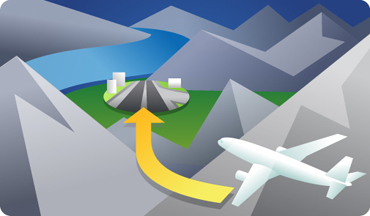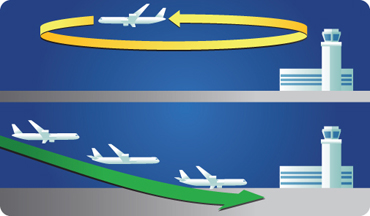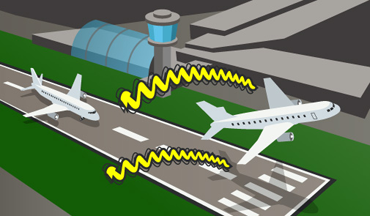Mobile technology has changed how we interact with the world, as anyone who uses a smartphone can attest.
Just as smartphones have altered our social, professional and home lives, rapid improvements in hardware, software and wireless connectivity have ushered the air travel industry into the digital age. Air travelers feel the effects of technological advancement pre-flight, at airports and on aircraft, and they have come to expect even more implementation of new technology to enhance the travel experience.
Many technological advances in aviation worldwide arose in recent years as demand increased for greater flight safety and airport security, as well as increased passenger convenience and autonomy. Here are a few ways technology has changed how travelers experience flight.
More Efficiency from Point A to Point B
The Federal Aviation Administration (FAA) operates the NextGen project, a recent $1.6 billion investment in technology across the entirety of the National Airspace System. An additional $11.4 billion in improvements is expected over the next 15 years.
The goal of NextGen is to implement state-of-the-art technologies and procedures that “enable aircraft to move more directly from Point A to Point B,” according to the FAA. Here are a few examples of NextGen programs that already are in use in an attempt to improve efficiency:
- Performance-Based Navigation – Employs more-precise satellites and onboard navigation equipment, rather than standard avionics and ground-based navigation aids. When pilots no longer must fly from ground-based transmitters to the next to maintain a known course, the flight path can be more direct and fuel-efficient.
- Equivalent Lateral Spacing Operations – The takeoff and landing of aircraft equipped with performance-based navigation equipment can be measured more accurately, allowing more flights to depart from a particular runway in a shorter amount of time. This also reduces taxi time to and from gates.
- Wake Turbulence Recategorization – Also known as Wake RECAT, this is defined by the FAA “as a safe decrease in separation standards.” Wake turbulence is the disturbance of air behind a moving aircraft, which can be hazardous if passed through by another aircraft. At several airports around the United States, the FAA changed its separation standards after a decade of research into safe wake zones and the advent of more accurate navigation equipment.
The FAA also funds a number of major capital programs intended to improve the efficiency and safety of the National Airspace System. Programs currently under development apply to improvements in navigation, telecommunications, computer processing, surveillance, weather monitoring and prediction, as well as tools for air traffic controllers.Reducing Delays at ‘Pinch Points’
In addition to improved methods to ensure smoother movement from Point A to Point B, streamlining the air travel experience requires the development of technology-driven plans that reduce the delaying effect of various “pinch points” in the air travel experience.
Potential “pinch points” include check-in, passport control, baggage check, gates, parking, customer service kiosks and other traditional instances of face-to-face interaction between a passenger and an airport or airline staffer, or a Transportation Security Administration officer.
Airport planners and airlines around the world are using a wide variety of devices, software and Wi-Fi-enabled hardware to ease the travel process for passengers. Technological conveniences include:
- Mobile and wearable technology – Passengers can purchase tickets, track flights, download boarding passes, receive schedule updates and much more by using their smartphones, smart watches, tablets and laptops. Some airlines furnish flight attendants with tablets that allow them to help passengers with in-flight rebooking if a connecting flight is delayed or canceled. Airlines also are moving away from the built-in, small-screen model for in-flight entertainment and toward passenger use of personal mobile devices such as tablets and smartphones to watch programming, retrieve flight information and play games.
- Beacons and Near Field Communication – The relatively new near field communication (NFC) and beacon technologies make use of apps to create contextually aware, customized experiences based on passengers’ past behavior and location. This is used to enhance loyalty programs in Nice, France; to provide airport navigation in Miami, Florida; to alert terminal-side passengers to sales and promotions at nearby retail outlets in Mumbai, India; to create a personalized welcome message at Heathrow Airport in London; even to enable visually impaired passengers to navigate the San Francisco airport using voice technology.
- Improved baggage drop and pickup – Member airports in the International Air Transport Association (IATA) must be in compliance with IATA Resolution 753 by June 2018, which means they are required to maintain an accurate inventory of luggage by monitoring acquisition and delivery. The purpose of the resolution is to reduce instances of lost or delayed luggage, a goal that can be met using advances such as biometric-enabled bag drop locations and e-tags that are printable by the passenger at home or a hotel.
Robots Take on Tasks
There is one more major advance in airport technology that could have been ripped straight from the script of the 1960s animated show, “The Jetsons.” Robots have been introduced at airports in Geneva (Switzerland), Auckland (New Zealand) and Tokyo to perform tasks as simple as luggage transport and as complex as cleaning.
In 2015, KLM Royal Dutch Airlines rolled out Spencer, a robot “tour guide” with the ability to converse with and perceive the emotions of passengers at Amsterdam Airport Schiphol. Spencer even has the ability to respond to minor crises, such as spills or a crowded terminal.
What’s Next?
Advances in the depth and adaptability of artificial intelligence (AI) could revolutionize the way robots are used in airports. Cognitive technology research is ongoing, and Middle East airline Etihad recently agreed to a $700 million partnership with IBM to explore the uses of AI using the IBM Watson technology platform.
The 2016 IATA Global Passenger Survey revealed that passengers want even greater autonomy, with wider availability of technology-enabled functionality such as mobile boarding passes, instant check-in on arrival, automated security checks and better airline-to-customer communication about flight status, baggage status and wait times.


